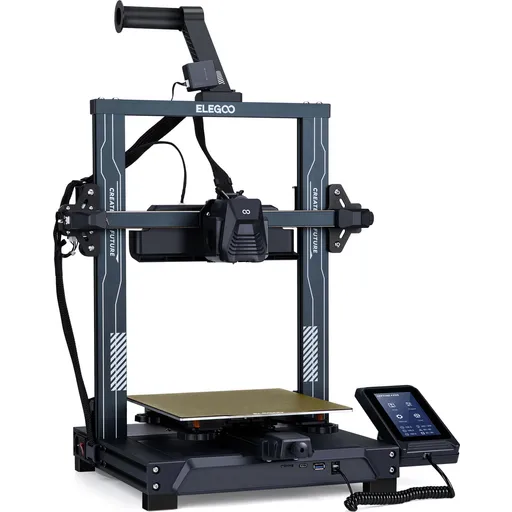Compare Neptune 4 PRO vs H2D
Comparison between the best 3D printers
Choose the best 3D printer at the best price. The cheapest 3D printers are here.
Buy a 3D printer here with 3D Fila.
 |
 |
|
| Model | Neptune 4 PRO |
H2D |
| Printing Material | Filament | Filament |
| Buy Filament for Elegoo Neptune 4 PRO | Buy Filament forBambu Lab H2D | |
| Estimated price | $359,00 | $1899,00 |
| Manufacturer | Elegoo | Bambu Lab |
| Release Year | 2023 | 2025 |
| Print Volume [mm] | 225x225x265 | 350x320x325 |
| Printer Size [mm] | 475x445x515 | 492x514x626 |
| Weight [kg] | 8,9 | 42,3 |
| Power Loss Recovery | YES | YES |
| Enclosed printer | NO | YES |
| Bed Leveling | Automatic | Automatic |
| Filament End Sensor | YES | YES |
| Bed type | Heated | Heated |
| Power supply system | Direct Drive | Direct Drive |
| Standard nozzle | 0,4 | 0,4 |
| Maximum Nozzle Temperature [°C] | 300 | 350 |
| Maximum Bed Temperature [°C] | 110 | 120 |
| Maximum printing speed [mm/s] | 500 | 600 |
| Filament holder | YES | YES |
| Camera for supervision | NO | NO |
| Recommended filaments | PLA, PLA+, TPU, PETG, Nylon, ABS | PLA, PETG, ABS, ASA, TPU, PVA, Nylon (PA) |
| Recommended slicers | Bambu Studio, Super Slicer, Cura, Prusa Slicer, Orca | Bambu Studio |
| Maximum Resolution [mm] | 0,1 | 0,01 |
| Processor | ARM 64 bit | |
| Display | Touchscreen 4,3'' | Touchscreen 5'' |
| Power Supply | 310 W | |
| Connectivity | USB, microSD | Wifi, Bambu bus, Cartão SD |
| Operating systems | Windows, Linux, Macbook | Windows, Mac, Linux |
| Date of registration in the system | 2024-07-02 | 2025-03-31 |
| Release date | 2023 | 2025 |
| Extra features | The Elegoo Neptune 4 Pro stands out for its advanced features, including pre-installed Klipper firmware, a dual-gear direct extruder with a 5.2:1 ratio, a high-temperature nozzle (up to 300°C), a flexible magnetic PEI platform, efficient cooling fans, and a 121-point auto-leveling system. The printer also features a 4.3-inch touchscreen interface, dual linear bars on the X and Y axes, and a segmented heated bed for energy savings. | Bambu Labs H2D combines high-speed 3D printing with a chamber heated up to 65 °C, dual extrusion with automatic nozzle switching, an AMS for filament drying and exchange, and AI sensors that detect failures. It offers optional laser and digital cutting capabilities, features intelligent calibration through computer vision, vibration control, enhanced fire safety, and real-time camera monitoring. |
| Support for multiple colors and materials (AMS and CFS) | NO | YES |
Notes * |
||
| Cost-benefit | 7 / 10 | 7 / 10 |
| Hardware | 3.2 / 10 | 8 / 10 |
| Tela | . | . |
| Print volume | 3 / 10 | 4 / 10 |
| Performance | 4 / 10 | 5 / 10 |
Conclusion |
| In comparing the Elegoo Neptune 4 PRO and the Bambu Lab H2D, it is evident that both models have their unique strengths, catering to different user needs and preferences. The Neptune 4 PRO is positioned as a cost-effective option that delivers a respectable set of features for its price. With its compact design, efficient print volume, and a solid range of compatible filaments, it serves as a great choice for hobbyists and those new to 3D printing. Highlighted features such as automatic bed leveling and a user-friendly interface make it an appealing option for users seeking simplicity without sacrificing performance. On the other hand, the H2D offers advanced capabilities and higher specifications, ideal for professional users or serious enthusiasts. With a larger print volume, higher maximum nozzle temperatures, and additional features like dual extrusion and intelligent calibration, it excels in versatility and speed. Its enclosed design and enhanced safety features further improve its suitability for complex projects. While the Neptune 4 PRO provides excellent value, especially for entry-level users, the H2D delivers significant advancements for those willing to invest more for professional-grade results. Ultimately, the decision between the two models boils down to the user’s specific requirements, budget constraints, and desired capabilities in their 3D printing journey. |

